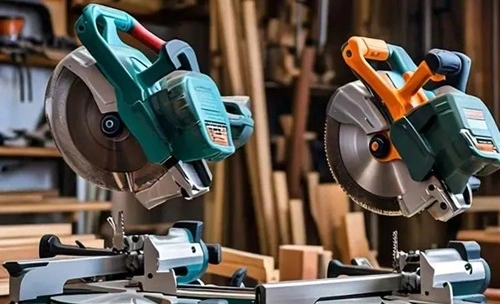A miter saw is a versatile power tool used for making precise crosscuts, miter cuts, and bevel cuts. Whether you’re a professional carpenter, a DIY enthusiast, or someone working on home improvement projects, a miter saw is an essential tool in your arsenal. Among the various types of miter saws available, the single bevel miter saw and the double bevel miter saw are two popular options. While both serve the same fundamental purpose, their capabilities, design, and applications vary significantly.
This article explores the difference between a single and double bevel miter saw, helping you understand their unique features, advantages, and the best use cases for each.
What Is a Single Bevel Miter Saw?

A single bevel miter saw is designed to tilt the saw blade in one direction, typically to the left, to make bevel cuts. This means the saw can only cut bevels on one side of the material at a time. If you need to make bevel cuts on the opposite side, you’ll need to flip the material manually.
Key Features of Single Bevel Miter Saw:
- Bevel Cutting Direction: Tilts in one direction (usually left).
- Simple Design: Easier to operate and maintain.
- Cost: Generally more affordable than double bevel miter saws.
- Best For: Basic bevel cuts, miter cuts, and crosscuts.
What Is a Double Bevel Miter Saw?
A double bevel miter saw (also known as a dual bevel miter saw) can tilt the blade in both directions—left and right. This feature eliminates the need to flip the material when making bevel cuts on both sides, saving time and effort.
Key Features of Double Bevel Miter Saw:
- Bevel Cutting Direction: Tilts in both directions.
- Advanced Design: More versatile for complex projects.
- Cost: Typically more expensive than single bevel miter saws.
- Best For: Advanced woodworking, crown molding, and intricate bevel cuts.
Key Differences Between Single and Double Bevel Miter Saw
| Feature | Single Bevel Miter Saw | Double Bevel Miter Saw |
|---|---|---|
| Bevel Capability | Tilts in one direction (usually left). | Tilts in both left and right directions. |
| Versatility | Suitable for basic bevel cuts and miter cuts. | Ideal for advanced and repetitive bevel cuts. |
| Material Flipping | Requires flipping the material for opposite bevels. | No flipping needed for opposite bevel cuts. |
| Ease of Use | Simpler and easier for beginners. | Slightly more complex to operate. |
| Time Efficiency | Takes more time for bevel cuts on both sides. | Saves time on complex cuts. |
| Cost | More affordable, budget-friendly. | More expensive due to additional functionality. |
| Applications | Basic woodworking and DIY projects. | Professional use, crown molding, and advanced carpentry. |
Detailed Comparison
1. Bevel Cutting
- Single Bevel Miter Saw: Only tilts in one direction. If you need to make a bevel cut on the opposite side, you must manually flip the material.
- Double Bevel Miter Saw: Tilts in both directions, allowing you to make bevel cuts on both sides without repositioning the material. This is particularly useful for repetitive or complex cuts.
2. Complexity and Ease of Use
- Single Bevel Miter Saw: Its simple design makes it easier to use, especially for beginners. It’s an excellent choice for straightforward projects that don’t require complex cuts.
- Double Bevel Miter Saw: The additional tilt direction adds versatility but also slightly increases the learning curve. It’s better suited for professionals or those with experience.
3. Efficiency
- Single Bevel Miter Saw: Requires more effort and time since flipping the material is necessary for certain cuts. This can be cumbersome for larger or heavier pieces of material.
- Double Bevel Miter Saw: More efficient for large projects, as it reduces the need for flipping and repositioning material, speeding up the workflow.
4. Cost
- Single Bevel Miter Saw: More affordable due to its simpler design and fewer features. It’s a budget-friendly option for DIY enthusiasts or hobbyists.
- Double Bevel Miter Saw: Costs more because of its advanced features and increased versatility. It’s an investment for professionals and frequent users.
5. Applications
- Single Bevel Miter Saw: Best for straightforward woodworking tasks such as basic miter cuts, framing, and trimming. It’s sufficient for projects like building furniture or small home renovations.
- Double Bevel Miter Saw: Ideal for intricate work such as crown molding, baseboards, and cabinetry. Its ability to make precise bevel cuts on both sides makes it the go-to tool for professional carpentry.
When to Choose a Single Bevel Miter Saw
A single bevel miter saw is a practical choice if:
- You’re working on basic projects like trimming or framing.
- You’re a beginner or casual woodworker.
- Your budget is limited.
- You don’t require complex or repetitive bevel cuts.
Examples of Projects:
- Building picture frames.
- Installing baseboards.
- Crafting simple furniture pieces.
When to Choose a Double Bevel Miter Saw
A double bevel miter saw is the better option if:
- You’re a professional carpenter or work on complex woodworking projects.
- You frequently cut crown molding or baseboards.
- You want to save time and effort by avoiding the need to flip materials.
- You’re willing to invest in a versatile and efficient tool.
Examples of Projects:
- Cutting intricate crown molding for ceilings.
- Building custom cabinetry.
- Working on large-scale or professional carpentry projects.
Pros and Cons of Single Bevel Miter Saw
Pros:
- Cost-Effective: Affordable for budget-conscious buyers.
- Simple Design: Easier to use, especially for beginners.
- Lightweight: More portable than double bevel models.
Cons:
- Time-Consuming: Requires flipping materials for opposite bevel cuts.
- Limited Versatility: Not suitable for complex or large-scale projects.
Pros and Cons of Double Bevel Miter Saw
Pros:
- Versatile: Can handle a wider range of cuts.
- Time-Saving: Eliminates the need to flip materials.
- Professional Quality: Delivers precise and consistent results.
Cons:
- Expensive: Higher upfront cost.
- Complexity: Slightly more challenging for beginners to master.
Tips for Choosing the Right Miter Saw
- Evaluate Your Needs: Consider the type of projects you’ll be working on. If most of your tasks involve simple cuts, a single bevel miter saw should suffice. For complex projects, invest in a double bevel miter saw.
- Budget: Determine how much you’re willing to spend. A single bevel miter saw is budget-friendly, while a double bevel model is an investment.
- Frequency of Use: If you’re a professional or frequent user, the efficiency and versatility of a double bevel miter saw make it worthwhile.
- Space and Portability: Single bevel miter saws are typically lighter and more compact, making them easier to store and transport.
Conclusion
The difference between a single bevel miter saw and a double bevel miter saw primarily lies in their versatility, functionality, and target user. A single bevel miter saw is an excellent choice for beginners, casual woodworkers, or those with simpler projects. On the other hand, a double bevel miter saw is ideal for professionals or anyone working on intricate, large-scale projects that demand precision and efficiency.
By understanding your needs, budget, and project requirements, you can select the right miter saw to enhance your woodworking experience and achieve the best results. Whether you’re framing, trimming, or crafting elaborate designs, there’s a miter saw perfectly suited for your goals.



